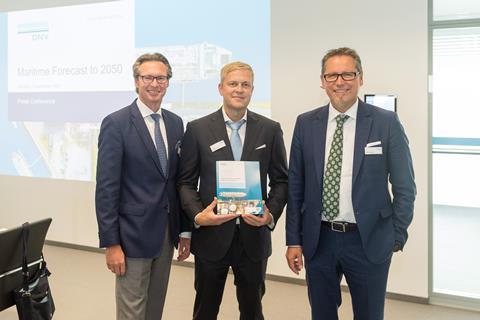The comprehensive production, distribution and bunkering infrastructures required to enable the maritime industry’s shift to carbon-neutral fuels is the “ultimate hurdle” according to DNV’s latest Maritime Forecast to 2050 report.

A key component of DNV’s Energy Transition Outlook (ETO) suite of reports, the 84-page forecast is the sixth edition of its kind. This year’s report has a focus on how to overcome fuel availability, while also presenting an updated outlook on regulations, drivers, future technologies, and costs for decarbonising shipping.
It models two different decarbonisation pathways: current IMO ambitions to 2050; and full decarbonisation by 2050. DNV’s modelling points to a diverse future energy mix comprising both fossil and carbon-neutral fuels, with fossil fuels gradually phased out by 2050.
“The search for the best alternative carbon-neutral fuel options and technologies is under way as the entire world seeks to decarbonise,” said DNV Maritime ceo Knut Ørbeck-Nilssen. “No industry can decarbonise in isolation so global industries need to make the right choices together, and sustainable energy should be directed to where it has the biggest impact on reducing GHG emissions. The ultimate hurdle is fuel availability and to overcome it, supply chains must be built through cross-industry alliances.
“Carbon-neutral fuels must be made available for ships already within this decade, in decarbonisation pathways assessed. By no later than 2030, 5 percent of the energy for shipping should come from carbon-neutral fuels. This will require substantial investments in both onboard technologies and onshore infrastructure,” he added.
Coordinated plans by all stakeholders, including major energy and fuel providers and ports, is crucial while public incentives must encourage first movers to participate in a nascent global network of green shipping corridors.
The report’s new and extended fuel-mix scenario library for shipping can be applied to DNV’s updated carbon-risk-framework to help shipowners find the most efficient and cost-effective fuel strategies. Focusing on fuel flexibility and energy efficiency remains key to easing the transition and minimising the risk of investing in stranded assets, added DNV.
In terms of fuel choice, uncertainties around future price and availability means that a clear winner among the many options – ammonia, methanol, diesel or methane, produced from sustainable biomass, renewable electricity or fossil fuels with carbon capture and storage (CCS) – cannot be identified yet or in the near future.
“Our findings add to the body of research evidence that owners need to take confident, robust long-term decisions on the investments needed for their existing fleet and newbuilding projects,” said Eirik Ovrum, DNV Maritime principal consultant and Maritime Forecast to 2050 lead author.
“We probe variations on three fuel families in which we simulate the availability of sustainable biomass to produce biofuels, renewable electricity to produce e-fuels, and fossil fuels in combination with CCS to produce blue fuels. We also explore variations for specific fuel types, in which key input factors impacting the relative cost differences between fuels within each family are scrutinised. In total we explore 24 decarbonisation scenarios.”
The fuel transition has already started, with 5.5 percent of ships (gross tonnage) in operation and 33 percent of gross tonnage on order today able to operate on alternative fuel (largely dominated by LNG).
DNV forecasts that onboard technology investments required for the decarbonisation by 2050 pathway scenarios will range from USD8-28 billion per year (depending on which fuel type has the largest uptake) between 2022 and 2050. Investments of between USD30-90 billion per year to 2050 are needed for the onshore fuel supply chains.
“Two thousand ships are expected to be ordered annually to 2030 but there is still no silver-bullet fuel solution available,” said Ørbeck-Nilssen. “Against this uncertainty, the new Maritime Forecast to 2050 report can serve as a beacon of expert advice and smart solutions to ensure vessels stay commercially competitive and compliant over their lifetimes, underpinned throughout by the enduring need for safety.”
Other issues
Another pressing challenge for the shipping industry is compliance with the EU Emissions Trading Scheme (ETS). The European Commission’s Fit for 55 package aims to reduce CO2 emissions in the bloc by 55 percent over 1990 levels by 2030.
















